#data science books publishers
Explore tagged Tumblr posts
Text

PM Publishers Pvt. Ltd. (PMP) is a leading publishing house of educational school books. PMP books incorporate the projected NEP 2020, NIPUN BHARAT and NCF 2022 guidelines by MHRD, Gol, the Department of School Education & Literacy, MoE, Gol, and NCERT respectively. For providing cost-effective quality books, the prescribed curriculum framed by NCERT/ SCERT based for the CBSE, ICSE and other state boards forms a basis for us to cater to the needs of all stakeholders. In a short span of time, the house has created a niche amongst educators. More than 4000 established schools both in India and abroad have already appreciated the significant presence of our books. The books are supported with the latest technology like AR Apps, Multimedia, Assessment Tools, Question Paper Generator, and Quiz Generator. Explore more
Links: https://www.pmpublishers.in/
#Books publishers#computer books publishers#gk books publishers#art & craft books publishers#artificial intelligence books publishers#data science books publishers#english grammar books publishers#environmental studies books publishers.
2 notes
·
View notes
Text
NASA Inspires Your Crafty Creations for World Embroidery Day
It’s amazing what you can do with a little needle and thread! For #WorldEmbroideryDay, we asked what NASA imagery inspired you. You responded with a variety of embroidered creations, highlighting our different areas of study.
Here’s what we found:
Webb’s Carina Nebula

Wendy Edwards, a project coordinator with Earth Science Data Systems at NASA, created this embroidered piece inspired by Webb’s Carina Nebula image. Captured in infrared light, this image revealed for the first time previously invisible areas of star birth. Credit: Wendy Edwards, NASA. Pattern credit: Clare Bray, Climbing Goat Designs
Wendy Edwards, a project coordinator with Earth Science Data Systems at NASA, first learned cross stitch in middle school where she had to pick rotating electives and cross stitch/embroidery was one of the options. “When I look up to the stars and think about how incredibly, incomprehensibly big it is out there in the universe, I’m reminded that the universe isn’t ‘out there’ at all. We’re in it,” she said. Her latest piece focused on Webb’s image release of the Carina Nebula. The image showcased the telescope’s ability to peer through cosmic dust, shedding new light on how stars form.
Ocean Color Imagery: Exploring the North Caspian Sea

Danielle Currie of Satellite Stitches created a piece inspired by the Caspian Sea, taken by NASA’s ocean color satellites. Credit: Danielle Currie/Satellite Stitches
Danielle Currie is an environmental professional who resides in New Brunswick, Canada. She began embroidering at the beginning of the Covid-19 pandemic as a hobby to take her mind off the stress of the unknown. Danielle’s piece is titled “46.69, 50.43,” named after the coordinates of the area of the northern Caspian Sea captured by LandSat8 in 2019.

An image of the Caspian Sea captured by Landsat 8 in 2019. Credit: NASA
Two Hubble Images of the Pillars of Creation, 1995 and 2015
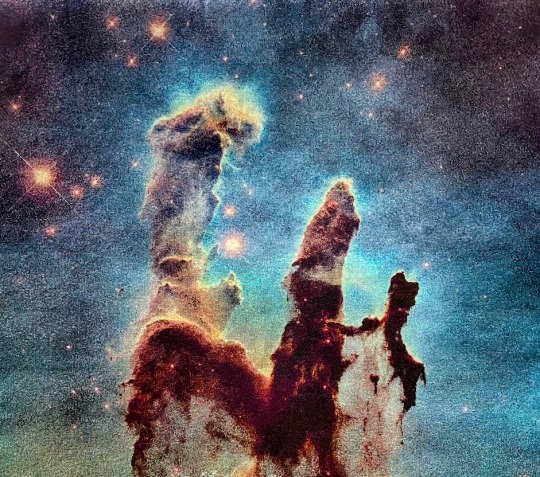
Melissa Cole of Star Stuff Stitching created an embroidery piece based on the Hubble image Pillars of Creation released in 1995. Credit: Melissa Cole, Star Stuff Stitching
Melissa Cole is an award-winning fiber artist from Philadelphia, PA, USA, inspired by the beauty and vastness of the universe. They began creating their own cross stitch patterns at 14, while living with their grandparents in rural Michigan, using colored pencils and graph paper. The Pillars of Creation (Eagle Nebula, M16), released by the Hubble Telescope in 1995 when Melissa was just 11 years old, captured the imagination of a young person in a rural, religious setting, with limited access to science education.
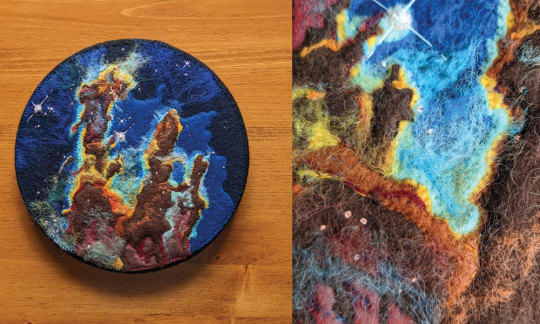
Lauren Wright Vartanian of the shop Neurons and Nebulas created this piece inspired by the Hubble Space Telescope’s 2015 25th anniversary re-capture of the Pillars of Creation. Credit: Lauren Wright Vartanian, Neurons and Nebulas
Lauren Wright Vartanian of Guelph, Ontario Canada considers herself a huge space nerd. She’s a multidisciplinary artist who took up hand sewing after the birth of her daughter. She’s currently working on the illustrations for a science themed alphabet book, made entirely out of textile art. It is being published by Firefly Books and comes out in the fall of 2024. Lauren said she was enamored by the original Pillars image released by Hubble in 1995. When Hubble released a higher resolution capture in 2015, she fell in love even further! This is her tribute to those well-known images.
James Webb Telescope Captures Pillars of Creation

Darci Lenker of Darci Lenker Art, created a rectangular version of Webb’s Pillars of Creation. Credit: Darci Lenker of Darci Lenker Art
Darci Lenker of Norman, Oklahoma started embroidery in college more than 20 years ago, but mainly only used it as an embellishment for her other fiber works. In 2015, she started a daily embroidery project where she planned to do one one-inch circle of embroidery every day for a year. She did a collection of miniature thread painted galaxies and nebulas for Science Museum Oklahoma in 2019. Lenker said she had previously embroidered the Hubble Telescope’s image of Pillars of Creation and was excited to see the new Webb Telescope image of the same thing. Lenker could not wait to stitch the same piece with bolder, more vivid colors.
Milky Way

Darci Lenker of Darci Lenker Art was inspired by NASA’s imaging of the Milky Way Galaxy. Credit: Darci Lenker
In this piece, Lenker became inspired by the Milky Way Galaxy, which is organized into spiral arms of giant stars that illuminate interstellar gas and dust. The Sun is in a finger called the Orion Spur.
The Cosmic Microwave Background
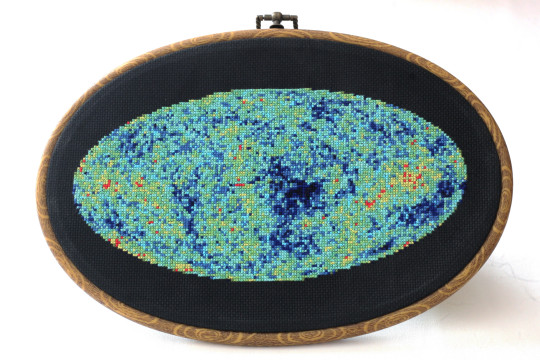
This image shows an embroidery design based on the cosmic microwave background, created by Jessica Campbell, who runs Astrostitches. Inside a tan wooden frame, a colorful oval is stitched onto a black background in shades of blue, green, yellow, and a little bit of red. Credit: Jessica Campbell/ Astrostitches
Jessica Campbell obtained her PhD in astrophysics from the University of Toronto studying interstellar dust and magnetic fields in the Milky Way Galaxy. Jessica promptly taught herself how to cross-stitch in March 2020 and has since enjoyed turning astronomical observations into realistic cross-stitches. Her piece was inspired by the cosmic microwave background, which displays the oldest light in the universe.

The full-sky image of the temperature fluctuations (shown as color differences) in the cosmic microwave background, made from nine years of WMAP observations. These are the seeds of galaxies, from a time when the universe was under 400,000 years old. Credit: NASA/WMAP Science Team
GISSTEMP: NASA’s Yearly Temperature Release

Katy Mersmann, a NASA social media specialist, created this embroidered piece based on NASA’s Goddard Institute for Space Studies (GISS) global annual temperature record. Earth’s average surface temperature in 2020 tied with 2016 as the warmest year on record. Credit: Katy Mersmann, NASA
Katy Mersmann is a social media specialist at NASA’s Goddard Space Flight Center in Greenbelt, Md. She started embroidering when she was in graduate school. Many of her pieces are inspired by her work as a communicator. With climate data in particular, she was inspired by the researchers who are doing the work to understand how the planet is changing. The GISTEMP piece above is based on a data visualization of 2020 global temperature anomalies, still currently tied for the warmest year on record.
In addition to embroidery, NASA continues to inspire art in all forms. Check out other creative takes with Landsat Crafts and the James Webb Space telescope public art gallery.
Make sure to follow us on Tumblr for your regular dose of space!
#NASA#creativity#fiber art#embroidery#art#art challenge#needlework#crafts#handmade#textile art#cross stitch#stitching#inspiration#inspo#Earth#Earth science#Hubble#James Webb Space Telescope#climate change#water#nebula#stars
6K notes
·
View notes
Text
Why Are Goyim Obsessed With Bad People Being The Fault of The Jews?
How many times have we seen the speculation that certain truly horrific historical people must Jewish based the stringing of threads. Or the that said horrific people are horrific because of the Jews.
How many times have seen Hitler was actually a Jew conspiracy or that Hitler only became the way he did because he denied entry to art school by Jews conspiracy?
Not just with historical figures we all have seen how often it gets mentioned that Roy Cohen, Jew, and they sure do make a point to highlight that Jew part was behind Donald Trump being who he is.
Think about Henry Kissinger and how much him Jewish gets highlighted when talking his influence on Presidents Ford and Nixon, even though he hated being Jewish.
And of course we can not forget the all time go to Christopher Columbus as the secret Jew.
And now that is being reported to be in fact true. Just look at how everyone is reporting it.





Only that is not the case.
The documentary Columbus DNA. His True Origin, broadcast on Spain’s National Holiday suggests that the explorer was not Genoese and Christian but Spanish and Jewish. The absolute protagonist of the documentary, forensic scientist José Antonio Lorente, has not yet published any scientific study to back his claims. The documentary is presented in the style of a reality show in which Lorente systematically discounts other theories, including that Columbus was Castilian, Portuguese, Galician, Mallorcan or a Cagot. It culminates with a scene in which only one possibility remains, the one put forward by architect Francesc Albardaner, author of the book La catalanitat de Colom (or, The Catalonian Origins of Columbus).
But geneticist Antonio Alonso, former chief of the National Institute of Toxicology and Forensic Sciences, is not convinced: “Unfortunately, from the scientific point of view, no assessment can be made after watching the documentary, since it does not provide any data on what has been analyzed. My conclusion is that the documentary Columbus DNA does not show the DNA of Columbus at any given moment and scientists do not know what analysis has been undertaken.”
Forensic anthropologist Miguel Botella, also from the University of Granada, remembers that day in 2003 when he waited for the box containing the supposed bones of Christopher Columbus to be opened. “Everyone expected to be greeted by an intact Columbus, but there were only 150 grams of bone fragments,” he says with a smile. The largest would have been about four centimeters in length.
Lorente then said that he was going to analyze the DNA of the three alleged members of the Columbus family with the help of prestigious geneticists, such as Ángel Carracedo from the University of Santiago de Compostela; and Mark Stoneking, from the Max Planck Institute for Evolutionary Anthropology, in Leipzig, Germany, one of the world’s most prestigious centers for the analysis of ancient DNA. Carracedo recalls that the DNA that reached him was tremendously degraded, and he too distanced himself from the project. Moreover, he refuses to comment on Lorente’s new results until there is a serious scientific study published in a specialized journal. The response of the Max Planck Institute geneticist to questions from EL PAÍS were similar: “I am sorry, my group stopped working on this in 2005 and I have not heard anything about the most recent results,” said Stoneking.
According to geneticist Antonio Alonso, “It is not the done thing for data that the scientific community has not yet endorsed to be presented to society, as it puts the data itself at risk as well as the proposed theory.” Alonso is also surprised by the absence of experts from the U.S. and Australia in the film whose contribution Lorente describes as essential. “Here there is too much protagonism from only one scientist. Neither the Granada team nor the collaborating ancient DNA laboratories in California and Adelaide, which are said to be of great importance in the success of the analyses, appear in the film,” he points out. Recently retired, Alonso is one of Spain’s leading experts in forensic genetics. He worked on the identification of the victims of Madrid’s 11-M terror attacks; on the investigation of dozens of reports of alleged baby thefts; on the recognition of Spanish Civil War victims and even on the attempts to find the remains of the writer Miguel de Cervantes. He claims that the documentary Columbus DNA does not speak to him as a scientist. “We do not know which DNA regions were analyzed, nor the technology used in the analysis, nor the results obtained, which makes it impossible to make a correct assessment of the findings,” he says.
Alonso explains that there are clusters of genetic variants called haplotypes or haplogroups that tend to be inherited together and may be characteristic of certain family lineages, but he adds that they often coincide with those of other groups in historically Jewish or non-Jewish populations. “In any case, having a genealogy, a haplogroup or a haplotype of Jewish or Sephardic ancestry does not call into question Columbus’ birthplace in Genoa as stated by historical sources, nor does it tell us anything about the religious beliefs professed by the generations of relatives close to Columbus,” he says.
Rodrigo Barquera is a Mexican expert in archeogenetics at the Max Planck Institute for Evolutionary Anthropology. Barquera has conducted DNA studies of human remains prior to the arrival of Europeans in America, such as those of children sacrificed by the Maya at Chichén-Itzá in Mexico. The researcher is very critical of the fact the data have been presented via a documentary, and without the backing of a serious scientific article reviewed by independent experts, especially given the enormous interest in the figure of Christopher Columbus and his origins. “Normally, the article is sent to a scientific journal,” he says. “The journal assigns an editor and at least three independent reviewers who rate the paper and decide if it is scientifically valid. If it is, it is published, and then the rest of the scientific community can say whether they agree or not. Putting it on a screen, removed from this process and with all the media focus on it, makes it difficult for the scientific community to say anything about it.”
Antonio Salas heads the Population Genetics in Biomedicine team at Santiago de Compostela’s Health Investigation Institute. “The documentary promised to focus on DNA analysis, as suggested by its title Columbus DNA: His True Origins,” he says. “However, the genetic information it offers is very limited. Only at the end is it mentioned that the only thing that was recovered from the presumed remains of Christopher Columbus was a partial profile of the Y chromosome. The problem is that the Y chromosome represents only a tiny fraction of our DNA and our ancestry.” “The documentary rushes to a conclusion that Christopher Columbus was a Sephardic Jew originally from the Spanish Levant. This hypothesis is, to say the least, surprising: there is no Y chromosome that can be uniquely defined as Sephardic-Jewish,” argues Salas. “Even if all of an individual’s DNA were recovered, it would still be impossible to reach definitive conclusions about his or her exact geographic origin.
So when science seems to much more aligned with Columbus not being why then is everyone reporting him as Jewish. And why do goyim keep blaming every evil deed, every action, every evil choice and every evil person on Jews?
258 notes
·
View notes
Text
The Coprophagic AI crisis

I'm on tour with my new, nationally bestselling novel The Bezzle! Catch me in TORONTO on Mar 22, then with LAURA POITRAS in NYC on Mar 24, then Anaheim, and more!

A key requirement for being a science fiction writer without losing your mind is the ability to distinguish between science fiction (futuristic thought experiments) and predictions. SF writers who lack this trait come to fancy themselves fortune-tellers who SEE! THE! FUTURE!
The thing is, sf writers cheat. We palm cards in order to set up pulp adventure stories that let us indulge our thought experiments. These palmed cards – say, faster-than-light drives or time-machines – are narrative devices, not scientifically grounded proposals.
Historically, the fact that some people – both writers and readers – couldn't tell the difference wasn't all that important, because people who fell prey to the sf-as-prophecy delusion didn't have the power to re-orient our society around their mistaken beliefs. But with the rise and rise of sf-obsessed tech billionaires who keep trying to invent the torment nexus, sf writers are starting to be more vocal about distinguishing between our made-up funny stories and predictions (AKA "cyberpunk is a warning, not a suggestion"):
https://www.antipope.org/charlie/blog-static/2023/11/dont-create-the-torment-nexus.html
In that spirit, I'd like to point to how one of sf's most frequently palmed cards has become a commonplace of the AI crowd. That sleight of hand is: "add enough compute and the computer will wake up." This is a shopworn cliche of sf, the idea that once a computer matches the human brain for "complexity" or "power" (or some other simple-seeming but profoundly nebulous metric), the computer will become conscious. Think of "Mike" in Heinlein's *The Moon Is a Harsh Mistress":
https://en.wikipedia.org/wiki/The_Moon_Is_a_Harsh_Mistress#Plot
For people inflating the current AI hype bubble, this idea that making the AI "more powerful" will correct its defects is key. Whenever an AI "hallucinates" in a way that seems to disqualify it from the high-value applications that justify the torrent of investment in the field, boosters say, "Sure, the AI isn't good enough…yet. But once we shovel an order of magnitude more training data into the hopper, we'll solve that, because (as everyone knows) making the computer 'more powerful' solves the AI problem":
https://locusmag.com/2023/12/commentary-cory-doctorow-what-kind-of-bubble-is-ai/
As the lawyers say, this "cites facts not in evidence." But let's stipulate that it's true for a moment. If all we need to make the AI better is more training data, is that something we can count on? Consider the problem of "botshit," Andre Spicer and co's very useful coinage describing "inaccurate or fabricated content" shat out at scale by AIs:
https://papers.ssrn.com/sol3/papers.cfm?abstract_id=4678265
"Botshit" was coined last December, but the internet is already drowning in it. Desperate people, confronted with an economy modeled on a high-speed game of musical chairs in which the opportunities for a decent livelihood grow ever scarcer, are being scammed into generating mountains of botshit in the hopes of securing the elusive "passive income":
https://pluralistic.net/2024/01/15/passive-income-brainworms/#four-hour-work-week
Botshit can be produced at a scale and velocity that beggars the imagination. Consider that Amazon has had to cap the number of self-published "books" an author can submit to a mere three books per day:
https://www.theguardian.com/books/2023/sep/20/amazon-restricts-authors-from-self-publishing-more-than-three-books-a-day-after-ai-concerns
As the web becomes an anaerobic lagoon for botshit, the quantum of human-generated "content" in any internet core sample is dwindling to homeopathic levels. Even sources considered to be nominally high-quality, from Cnet articles to legal briefs, are contaminated with botshit:
https://theconversation.com/ai-is-creating-fake-legal-cases-and-making-its-way-into-real-courtrooms-with-disastrous-results-225080
Ironically, AI companies are setting themselves up for this problem. Google and Microsoft's full-court press for "AI powered search" imagines a future for the web in which search-engines stop returning links to web-pages, and instead summarize their content. The question is, why the fuck would anyone write the web if the only "person" who can find what they write is an AI's crawler, which ingests the writing for its own training, but has no interest in steering readers to see what you've written? If AI search ever becomes a thing, the open web will become an AI CAFO and search crawlers will increasingly end up imbibing the contents of its manure lagoon.
This problem has been a long time coming. Just over a year ago, Jathan Sadowski coined the term "Habsburg AI" to describe a model trained on the output of another model:
https://twitter.com/jathansadowski/status/1625245803211272194
There's a certain intuitive case for this being a bad idea, akin to feeding cows a slurry made of the diseased brains of other cows:
https://www.cdc.gov/prions/bse/index.html
But "The Curse of Recursion: Training on Generated Data Makes Models Forget," a recent paper, goes beyond the ick factor of AI that is fed on botshit and delves into the mathematical consequences of AI coprophagia:
https://arxiv.org/abs/2305.17493
Co-author Ross Anderson summarizes the finding neatly: "using model-generated content in training causes irreversible defects":
https://www.lightbluetouchpaper.org/2023/06/06/will-gpt-models-choke-on-their-own-exhaust/
Which is all to say: even if you accept the mystical proposition that more training data "solves" the AI problems that constitute total unsuitability for high-value applications that justify the trillions in valuation analysts are touting, that training data is going to be ever-more elusive.
What's more, while the proposition that "more training data will linearly improve the quality of AI predictions" is a mere article of faith, "training an AI on the output of another AI makes it exponentially worse" is a matter of fact.

Name your price for 18 of my DRM-free ebooks and support the Electronic Frontier Foundation with the Humble Cory Doctorow Bundle.

If you'd like an essay-formatted version of this post to read or share, here's a link to it on pluralistic.net, my surveillance-free, ad-free, tracker-free blog:
https://pluralistic.net/2024/03/14/14/inhuman-centipede#enshittibottification

Image: Plamenart (modified) https://commons.wikimedia.org/wiki/File:Double_Mobius_Strip.JPG
CC BY-SA 4.0 https://creativecommons.org/licenses/by-sa/4.0/deed.en
#pluralistic#ai#generative ai#André Spicer#botshit#habsburg ai#jathan sadowski#ross anderson#inhuman centipede#science fiction#mysticism
555 notes
·
View notes
Text
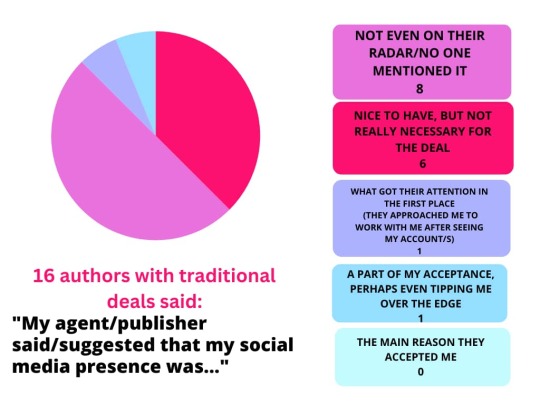
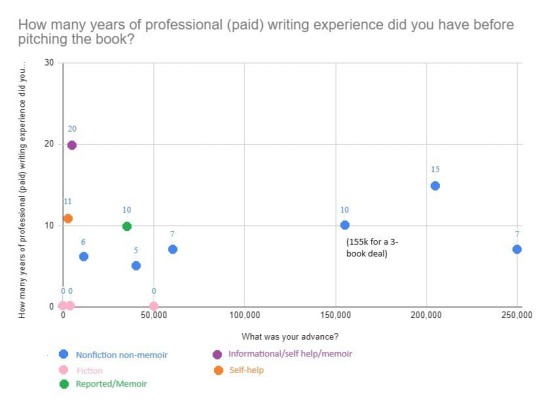
Do nonfiction authors really need social media to get a book deal?
I asked successful agents and trad signed authors how important social media is to getting book contracts. Here are some data and quotes about how they responded on my Authors of Nonfiction Books in Progress Substack! Read if you want more details and caveats to the data, as well as my story and why I like social media anyway.
TLDR: Social media is NOT necessary!
Here's an editorial explaining why. But for nonfiction non-memoir, you have to do something to prove that you know what you’re talking about, as you'll see repeated over and over in my Substack article. That proof could be social media.
Trad publishing is very hard and competitive, and sometimes even unfair. But the people who say "you can't get a deal unless you know someone or are TikTok famous" are flat-out wrong. (Also, you can become a person who knows someone by joining communities, attending conferences...hell, you can DM me if you have writing experience and I might hook you up with my agent. There, now you know someone and have no excuse. I've successfully hooked up 4 people I knew from communities I'm in, or something like that, not because they're my family members. I have said "come back when your query and/or experience are better" to 3 people, and 2 people didn't get the deal despite having good pitches and my recommendation, it just wasn't a match.)
Unfortunately, I think some aspiring authors are looking for an excuse, as many of these people don't often tend their writing craft. That is a much bigger indicator as to whether you'll get a deal, even if the trad world still isn't a perfect meritocracy.
Remember, I LOVE social media and have over 300,000 followers across platforms. I mostly do recommend that writers and journalists should use it! I find it sad, even, that there are so many writers with no audiences, when there are huge social audiences who would love to hear what these writers have to say! (But there are downsides too, so it's not ideal for all. Check out the pros and cons for science journalists being on TikTok.)
If you’d like to share your experience with trad publishing and social media (or lack of social media!), I still look at the survey results, so feel free to fill it out here and I may share the results in the future. Some questions are optional and of course I redact the (optional, anyway) emails:
132 notes
·
View notes
Text
We’re often told that it would be unfeasible for everyone on the planet to live good lives—that if there wasn’t some degree of poverty—or at least lower living standards—in the rest of the world, then we’d blow right through the ecological limits of the planet. Even if it’s not said explicitly, the argument is that some people need to be poor in order for us in the Global North to live good lives. There’s a lot wrong with this assumption on a lot of different levels, but most importantly—it’s empirically inaccurate. It is possible, in fact, for everybody on the planet to have their needs met and to live a good life and make it happen, in fact, with only 30 percent of current global resource and energy use. That might sound unbelievable, right? Well, that’s capitalist realism for you. Because not only is it believable—it’s based on solid research and empirical data. It would, however, require ending capitalism and moving towards eco-socialism. So yes, it’s possible. But it won’t be easy. To discuss the research behind these exciting findings we’ve brought on economic anthropologist Jason Hickel. Jason is a professor at the The Institute for Environmental Science and Technology at the Autonomous University of Barcelona, and the author of the books The Divide: A Brief Guide to Global Inequality and its Solutions and Less is More: How Degrowth will Save the World. He’s the lead author of the paper “How much growth is required to achieve good lives for all? Insights from needs-based analysis” published in the journal World Development Perspectives, and which we’ll be discussing today. As you may know, Jason is a regular guest on the show and was on most recently to discuss two other fascinating and important papers he recently co-authored, “Imperialist appropriation in the world economy: Drain from the global South through unequal exchange, 1990–2015” published in journal Global Environmental Change and "Unequal exchange of labour in the world economy" published in the journal Nature Communications. What assumptions go into traditional economic thinking and how have they limited the way we conceptualize poverty and how we address it? How do we conceive of good lives—and how does our current economic system limit these conceptions and perpetuate environmental destruction and social immiseration? What would an economic system that is designed around meeting actual human and planetary needs look like? And, perhaps most importantly, how do we get there? These are just some of the questions we discuss in this fascinating conversation with economic anthropologist Jason Hickel.
51 notes
·
View notes
Text
For three months this year, I bled nearly every day. My doctor doesn’t know why. Google doesn’t know why. The condition is simply called “postmenopausal bleeding,” and medicine’s best guess as to the cause is that the postmenopausal hormone-replacement therapy I started last November suddenly made my endometrium, the lining of the uterus, “unstable.” All scientific knowledge added up to “If it’s still happening in six months, get back in touch.” (I’m still bleeding intermittently, and I don’t know why.) This is the kind of massive medical shrug that anyone with female anatomy has probably encountered.
Despite major advances for women over the past 100 years—the invention of the contraceptive pill, greater access to safe abortions—much of female biology is still woefully underserved by science. There are reasons for this, most notably the historical exclusion of women from medical and pharmaceutical trials, partly because our awkward hormone cycles were thought to skew results. There’s also the fact that some scientists still project findings from research on men onto women, seeming not to realize that women aren’t just small men: Women are different down to the cellular level, meaning that many of our immune responses, experiences of pain, and symptoms (including, for instance, those that accompany a heart attack) may be different from men’s. Are you having a nasty, unexpected side effect from your medication? That could be because most drugs were developed with male bodies in mind. A 2020 review of 86 common medications, including antidepressants, cardiovascular drugs, and painkillers, found that women were likely routinely overmedicated and suffered adverse reactions nearly twice as often as men.
The lagging science is particularly apparent when it comes to periods and female hormones more generally—the subject of the anthropologist Kate Clancy’s new book, Period, a scientific and cultural history that purports to tell the “real story of menstruation.” Clancy’s book makes clear that a lack of data is to blame for many of the ills that women and girls face concerning their reproductive health, like doctors’ failure to diagnose painful conditions such as endometriosis.
My severe endometriosis was discovered only when I was 41, accidentally. For decades, I had been given prescription-strength painkillers, and my doctor never seemed to wonder whether the amount of pain I was in was abnormal. When I published an essay about my menopausal depression in 2018, a deluge of women wrote to tell me that when they were going through something similar, their doctors had told them they were imagining their brain fog or panic attacks, or had put them on antidepressants that didn’t work because many depression drugs are inadequate to treat the symptoms of fluctuating estrogen.
#feminism#save#menstruation#Medical misogyny#Period positivity#When I went to type in menstruation 'menstruation tw' was the 1st result
478 notes
·
View notes
Note
can u talk a bit more about working as a bibliographer? like what does that actually entail?
so the bibliography i worked at was affiliated with the major academic professional society of my subfield, and the society sponsors the bibliography as a kind of sister publication to their journal. this means 1) we were almost exclusively grant-funded, and 2) the staff positions at the bibliography go to grad students. there are jobs in bibliography and related information sciences that are not exclusive to academics/grad students, but i can't really tell you anything about them personally; i had this job as a graduate research assistant (ie this was what i did to get my paycheck for two years instead of TAing).
anyway the purpose of a bibliography like this that's affiliated with a journal or subfield is usually to aggregate data on what's published in that journal or subfield. ours was aimed at capturing the whole subfield. so, the bulk of the staff job is to comb through recent academic publications (journal articles & books) and pull anything that's topically relevant. we add the abstract and metadata to the bibliography (meaning basically a searchable database) and then we do subject tagging. this is the most fun part because you have to think about how knowledge is categorised and what's most useful to a user and whatnot.
so like let's say i'm entering an article from the journal of the history of psychiatry. i already pulled the metadata from the online journal listing and put it through zotero, which then talks to the bibliography's back end. i do the authority control (link it with the author's other publications in our bibliography, and with some external identity profile like viaf or orcid). i link it to the journal in our database and make sure it has the right date, page numbers, etc. this article is about philippe pinel, so its main category tag is probably 'psychiatry - 19th century'. then i aim for 5–10 additional subject tags, maybe 'france, metropolitan', 'psychiatric hospitals and institutions', 'therapy and therapeutic methods', 'philosophy of medicine', 'nosology and diagnosis', 'pitié-salpetrière hospice', etc.
once this is all entered, the article is searchable by any of its metadata, by going to the author's profile in our database, or by those subject and category tags. institutions (universities, libraries, hospitals, etc) all have their own authority controls too. you can browse the database by data, by subject tag, by searching keywords, etc; it also has a few visualisation tools that show strongly associated subject tags, histograms of a person's or publisher's history of publication, etc. this all means that things are more easily discoverable than they might be, and once you've found them you can also browse related things easily, or look at some provisional info on the state of publications in the field.
because this bibliography was affiliated with a journal, we also used to publish a yearly print edition with the entries published in the last year (this was satisfying to hold but honestly way less functional than the online database version lol) and we also published a special edition of bibliographic / historiographic essays on pandemics that i worked as managing editor for. idk how common this would be at other kinds of bibliographic job positions; we used the same publisher as the sister journal, so mostly all i had to do was correspond with people and deal with typesetting. anyway once that was published we also added those articles to the bibliography itself too.
anyway super fun job tbh, like a lot of it is data entry but haggling over subject tags was honestly enjoyable if you like that kind of thing. i lost the battle to add "total institutions" as a subject tag but won when i said we needed to revamp our system for entries dealing with weight management; as a result those subject tags are now clearer and more useful, and capture scientific discourses about both 'underweight' and 'overweight'. our best tag imo was "controversies and disputes", which was like a catch-all for any time there was some kind of haterism in the literature. it kind of changed how i view knowledge categorisation (like, the process; philosophy-of) and because we spent so much time reading abstracts to tag them, we would basically have walking encyclopedic knowledge of recent publishing in the field.
some of this functionality can ofc be replicated in library catalogues or google scholar or whatever, but the real value-add is the subject tagging and the relationships between those terms; this is where the bibliography is useful both for finding things and for showing an additional layer of information about the field and publishing in it. lots of academic fields have some equivalent of this, although i will say that our database was generally better (in the sense of more data and useful detail) than others i've used; it was a well-funded project run by a very dedicated prof who's been doing this for over 20 years now, and that continuity and institutional memory is really paying off for it.
but yeah if this is generally something that interests you, like i said, this is really just one specific form of bibliographic work. definitely look into what else is out there (i dunno how much of this would require a degree like an mlis even) and see what you think :)
20 notes
·
View notes
Text
Magneto and Science ↪ Part 1

the subtle hum of iron in blood, steel bending at his fingertips, the pull of Earth's core beneath his feet, wires and circuits speak, magnetic flux arcing between his hands, reading Einstein's equations, the muted thrum of power grids in distant cities, the metallic taste in the air before a storm, the distant buzz of high-voltage lines, the scent of ozone, strewn blueprint, the infinite spiral of energy, late night lights, monogrammed notes, wrapped books, late night discussions

↪ 𝐇𝐄𝐀𝐃𝐂𝐀𝐍𝐎𝐍𝐒
Magneto has many unfinished manuscripts and half-completed papers
⠀ ⠀𝐅𝐈𝐄𝐋𝐃𝐒 𝐎𝐅 𝐒𝐓𝐔𝐃𝐘: Electro and other types of magnetism, geophysics, interaction of magnetic frequencies with forces (plasma), theories on atoms / quantums / magnetism, mutant powers, ferromagnetism, fluid magnetism, metamagnetism, renewable energies, mechanics and engineering, Quantum-mechanical origin of magnetism, material science, space-centered development, the solarsystem, magnetars, earth's core and nature's magnetism, spacecraft propulsion based on manipulating planetary magnetic forces, Superconductivity Mechanisms, magnetic fibers (his suits)
⠀ ⠀𝙌𝙪𝙖𝙣𝙩𝙪𝙢 𝙈𝙖𝙜𝙣𝙚𝙩𝙤𝙥𝙡𝙖𝙨𝙢𝙖𝙙𝙮𝙣𝙖𝙢𝙞𝙘𝙨: Ambitious, albeit speculative, the interaction between quantum states and large-scale magnetic fields in plasmas. These theories suggest controlling the behavior of stars and cosmic bodies with magnetism—a kind of stellar engineering. Though untested, some astrophysicists have unknowingly referenced his work under pseudonyms in papers on solar magnetic field anomalies.
The science of Magneto and Gambit interacting creating a Magnetar or Black Hole -- not even Sinister mixes that.
His published works carry pseudonyms.
⠀ ⠀After his time on Asteroid M, various blueprints surfaced on inventions. Various particle colliders and electron molecule systems have been adjusted to the newly recognised modells.
⠀ ⠀His works push the boundaries of conventional scientific thought. Also quoting 'my powers' is ... debatable. (searching for proof of magnetic monopoles. reconcile the monopole with standard model inconsistencies, leaving behind cryptic hints for any physicist lucky (or unlucky) enough to find them.)
⠀ ⠀𝐓𝐇𝐄 "𝐌𝐀𝐆𝐍𝐄𝐓𝐎 𝐄𝐅𝐅𝐄𝐂𝐓": Electromagnetic Biophysics. A term coined to describe the phenomenon of magnetic fields influencing biological systems. It is oftentimes also used otherwise in sociopolitic studies.
He has funded numerous scientific research projects, often under pseudonyms. He is but a benevolent supporter ... (He gets along with Doc Ock and Bruce Banner occasionally)
⠀ ⠀Genosha utilised a large portion of his blueprints on renewable energies. The entire city layout was revolutionised for the purpose and therefore an almost "Solarpunk" city.
In later years, scientists call upon him for cross-referencing work and data in molecular and frequency studies. Also, sometimes he is also good for checking if a supercollider has a hole...
⠀ ⠀He does not like nanotech as it is more difficult to grasp.
⠀ ⠀Imagine some human scientist not realising they are basing all their work off of Magneto, the scary mutant terrorist. You try to avoid his study but you keep finding the name.
Scientific Magazines with his name and interviews
Young Mutants in school writing papers on him, or reports and they write him letters and he replies to their questions.
⠀ ⠀"We need to call him" - "We are NOT calling Magneto"
Some geophysicists unknowingly reference his work, citing unexplained phenomena in magnetic field fluctuations that were actually on him.
⠀ ⠀Sometimes you have to part the person (a mutant terrorist and villain) from its work -- or something.


#muse:magneto#--HATE AS YOU BREATHE || HEADCANONS#magneto and science#magneto#erik lensherr#x-men#max eisenhardt
28 notes
·
View notes
Text
What is a Cypherpunk?
The term "cypherpunk" refers to a movement and a community of activists advocating for the widespread use of strong cryptography and privacy-enhancing technologies as a route to social and political change. Emerging in the late 1980s and early 1990s, the cypherpunk movement is a confluence of libertarian political philosophy, hacker ethos, and cryptographic science.
The Core Traits of Cypherpunks
1. Advocacy for Privacy and Anonymity: Cypherpunks champion the right to privacy, emphasizing that individuals should have control over their personal information and digital footprints. This advocacy is often in direct opposition to government surveillance and corporate data collection practices.
2. Use of Cryptography: The cornerstone of the cypherpunk movement is the use of strong cryptography to secure communications and transactions. Cypherpunks believe that through cryptographic techniques, individuals can protect their privacy in the digital world.
3. Open Source and Decentralization: A significant trait among cypherpunks is the belief in open-source software and decentralized systems. This ethos promotes transparency, security, and resistance to censorship and control by central authorities.
Who are the Cypherpunks?
The cypherpunk community consists of programmers, activists, academics, and technologists. Notable figures include Julian Assange, the founder of WikiLeaks; Jacob Appelbaum, a former spokesperson for the Tor Project; and Hal Finney, a pioneer in digital cash systems. The manifesto "A Cypherpunk's Manifesto" by Eric Hughes (1993) [https://www.activism.net/cypherpunk/manifesto.html] eloquently encapsulates the philosophy and ideals of this movement.
The Cypherpunk Movement
Cypherpunks are not a formal organization but rather a loosely associated group sharing common interests in cryptography and privacy. The movement's origins can be traced to the “Cypherpunks” mailing list, started in 1992 by Eric Hughes, Timothy C. May, and John Gilmore. This list served as a platform for discussing privacy, cryptography, and related political issues.
Relation to Cyberpunk Principles
While cypherpunks share some overlap with the cyberpunk genre of science fiction, they are distinct in their real-world activism. Cyberpunk literature, like William Gibson's "Neuromancer" (1984) [https://www.goodreads.com/book/show/6088006-neuromancer], often presents a dystopian future where technology is pervasive and oppressive. In contrast, cypherpunks aim to use technology, specifically cryptography, as a tool for empowerment and resistance against such dystopian futures.
Notable Contributions and Technologies
The cypherpunk movement has been instrumental in the development of technologies that emphasize privacy and security:
Tor (The Onion Router): A free and open-source software for enabling anonymous communication [https://www.torproject.org/].
Pretty Good Privacy (PGP): A data encryption and decryption program that provides cryptographic privacy and authentication [https://www.openpgp.org/].
Bitcoin: The creation of Bitcoin by an individual or group under the pseudonym Satoshi Nakamoto was heavily influenced by the ideas of the cypherpunk movement. It embodies principles of decentralization and financial privacy [https://bitcoin.org/en/].
Wikileaks: Founded by Julian Assange, WikiLeaks is a multinational media organization that publishes news leaks and classified media provided by anonymous sources [https://wikileaks.org/].
Conclusion
The cypherpunk movement is a critical lens through which to view the ongoing dialogue about privacy, security, and freedom in the digital age. While not an organized group, the collective impact of cypherpunks on modern cryptography, internet privacy, and digital rights is profound. As digital technology continues to permeate every facet of our lives, the principles and contributions of the cypherpunk community remain more relevant than ever. - REV1.
84 notes
·
View notes
Text

(...) proponents of the Man the Hunter theory assumed evolution was acting primarily on men, and women were merely passive beneficiaries of both the meat supply and evolutionary progress.
(...) The modern physiological evidence, along with historical examples, exposes deep flaws in the idea that physical inferiority prevented females from partaking in hunting during our evolutionary past. The evidence from prehistory further undermines this notion.
(...) For those practicing a foraging subsistence strategy in small family groups, flexibility and adaptability are much more important than rigid roles, gendered or otherwise. Individuals get injured or die, and the availability of animal and plant foods changes with the seasons. All group members need to be able to step into any role depending on the situation, whether that role is hunter or breeding partner.
more discussion of the specific evidence in the article -- please give it a read! full text under readmore if you cant get the link to work
The Theory That Men Evolved to Hunt and Women Evolved to Gather Is Wrong
Cara Ocobock, Sarah Lacy
18 - 23 minutes
Even if you're not an anthropologist, you've probably encountered one of this field's most influential notions, known as Man the Hunter. The theory proposes that hunting was a major driver of human evolution and that men carried this activity out to the exclusion of women. It holds that human ancestors had a division of labor, rooted in biological differences between males and females, in which males evolved to hunt and provide and females tended to children and domestic duties. It assumes that males are physically superior to females and that pregnancy and child-rearing reduce or eliminate a female's ability to hunt.
Man the Hunter has dominated the study of human evolution for nearly half a century and pervaded popular culture. It is represented in museum dioramas and textbook figures, Saturday morning cartoons and feature films. The thing is, it's wrong.
Mounting evidence from exercise science indicates that women are physiologically better suited than men to endurance efforts such as running marathons. This advantage bears on questions about hunting because a prominent hypothesis contends that early humans are thought to have pursued prey on foot over long distances until the animals were exhausted. Furthermore, the fossil and archaeological records, as well as ethnographic studies of modern-day hunter-gatherers, indicate that women have a long history of hunting game. We still have much to learn about female athletic performance and the lives of prehistoric women. Nevertheless, the data we do have signal that it is time to bury Man the Hunter for good.
youtube
The theory rose to prominence in 1968, when anthropologists Richard B. Lee and Irven DeVore published Man the Hunter, an edited collection of scholarly papers presented at a 1966 symposium on contemporary hunter-gatherer societies. The volume drew on ethnographic, archaeological and paleoanthropological evidence to argue that hunting is what drove human evolution and resulted in our suite of unique features. "Man's life as a hunter supplied all the other ingredients for achieving civilization: the genetic variability, the inventiveness, the systems of vocal communication, the coordination of social life," anthropologist William S. Laughlin writes in chapter 33 of the book. Because men were supposedly the ones hunting, proponents of the Man the Hunter theory assumed evolution was acting primarily on men, and women were merely passive beneficiaries of both the meat supply and evolutionary progress.
But Man the Hunter's contributors often ignored evidence, sometimes in their own data, that countered their suppositions. For example, Hitoshi Watanabe focused on ethnographic data about the Ainu, an Indigenous population in northern Japan and its surrounding areas. Although Watanabe documented Ainu women hunting, often with the aid of dogs, he dismissed this finding in his interpretations and placed the focus squarely on men as the primary meat winners. He was superimposing the idea of male superiority through hunting onto the Ainu and into the past.
This fixation on male superiority was a sign of the times not just in academia but in society at large. In 1967, the year between the Man the Hunter conference and the publication of the edited volume, 20-year-old Kathrine Switzer entered the Boston Marathon under the name "K. V. Switzer," which obscured her gender. There were no official rules against women entering the race; it just was not done. When officials discovered that Switzer was a woman, race manager Jock Semple attempted to push her physically off the course.
At that time, the conventional wisdom was that women were incapable of completing such a physically demanding task and that attempting to do so could harm their precious reproductive capacities. Scholars following Man the Hunter dogma relied on this belief in women's limited physical capacities and the assumed burden of pregnancy and lactation to argue that only men hunted. Women had children to rear instead.
Today these biased assumptions persist in both the scientific literature and the public consciousness. Granted, women have recently been shown hunting in movies such as Prey, the newest installment of the popular Predator franchise, and on cable programs such as Naked and Afraid and Women Who Hunt. But social media trolls have viciously critiqued and labeled these depictions as part of a politically correct feminist agenda. They insist the creators of such works are trying to rewrite gender roles and evolutionary history in an attempt to co-opt "traditionally masculine" social spheres. Bystanders might be left wondering whether portrayals of women hunters are trying to make the past more inclusive than it really was—or whether Man the Hunter-style assumptions about the past are attempts to project sexism backward in time. Our recent surveys of the physiological and archaeological evidence for hunting capability and sexual division of labor in human evolution answer this question.
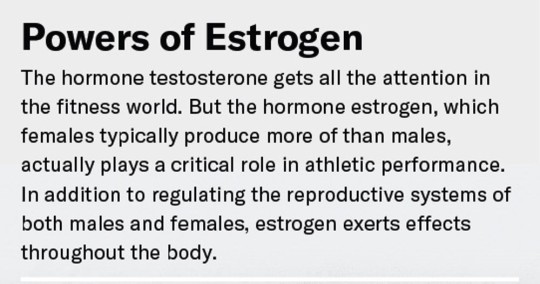

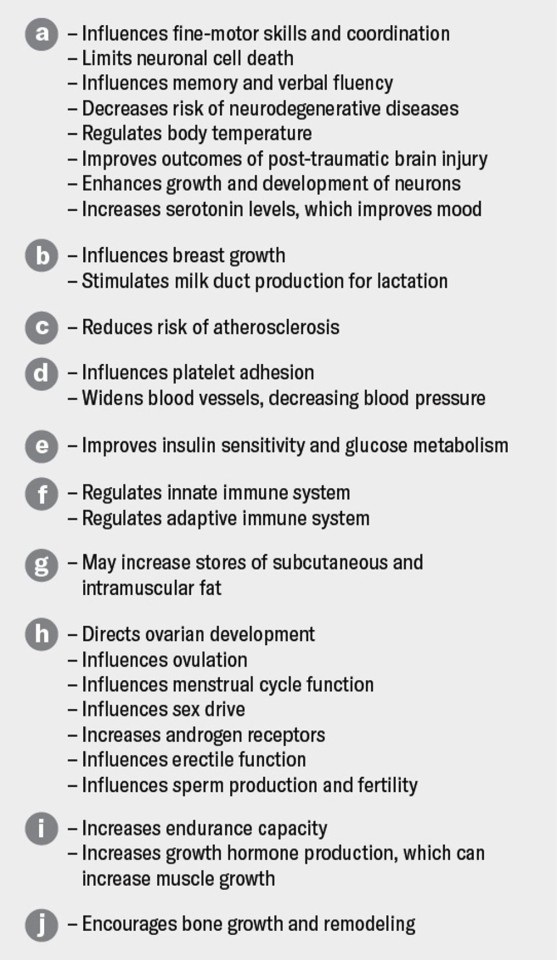
Credit: Violet Isabelle Frances for Bryan Christie Design
Before getting into the evidence, we need to first talk about sex and gender. "Sex" typically refers to biological sex, which can be defined by myriad characteristics such as chromosomes, hormone levels, gonads, external genitalia and secondary sex characteristics. The terms "female" and "male" are often used in relation to biological sex. "Gender" refers to how an individual identifies—woman, man, nonbinary, and so forth. Much of the scientific literature confuses and conflates female/male and woman/man terminology without providing definitions to clarify what it is referring to and why those terms were chosen. For the purpose of describing anatomical and physiological evidence, most of the literature uses "female" and "male," so we use those words here when discussing the results of such studies. For ethnographic and archaeological evidence, we are attempting to reconstruct social roles, for which the terms "woman" and "man" are usually used. Unfortunately, both these word sets assume a binary, which does not exist biologically, psychologically or socially. Sex and gender both exist as a spectrum, but it is difficult to add that nuance when citing the work of others.
It also bears mentioning that much of the research into exercise physiology, paleoanthropology, archaeology and ethnography has historically been conducted by men and focused on males. For example, Ella Smith of the Australian Catholic University and her colleagues found that in studies of nutrition and supplements, only 23 percent of participants were female. Emma Cowley, then at the University of North Carolina at Chapel Hill, and her colleagues found that among published studies focusing on athletic performance, only 6 percent had female-only participants; 31 percent looked exclusively at males. This massive disparity means we still know very little about female athletic performance, training and nutrition, leaving athletic trainers and coaches to treat females mostly as small males. It also means that much of the work we have to rely on to make our physiological arguments about female hunters in prehistory is based on research with small human sample sizes or rodent studies. We hope this state of affairs will inspire the next generation of scientists to ensure that females are represented in such studies. But even with the limited data available to us, we can show that Man the Hunter is a flawed theory and make the case that females in early human communities hunted, too.
From a biological standpoint, there are undeniable differences between females and males. When we discuss these differences, we are typically referring to means, averages of one group compared with another. Means obscure the vast range of variation in humans. For instance, although males tend to be larger and to have bigger hearts and lungs and more muscle mass, there are plenty of females who fall within the typical male range; the inverse is also true.
Overall, females are metabolically better suited for endurance activities, whereas males excel at short, powerful burst-type activities. You can think of it as marathoners (females) versus powerlifters (males). Much of this difference seems to be driven by the powers of the hormone estrogen.
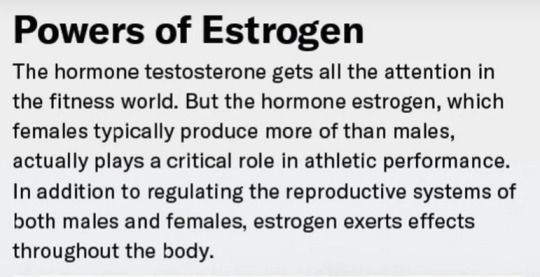
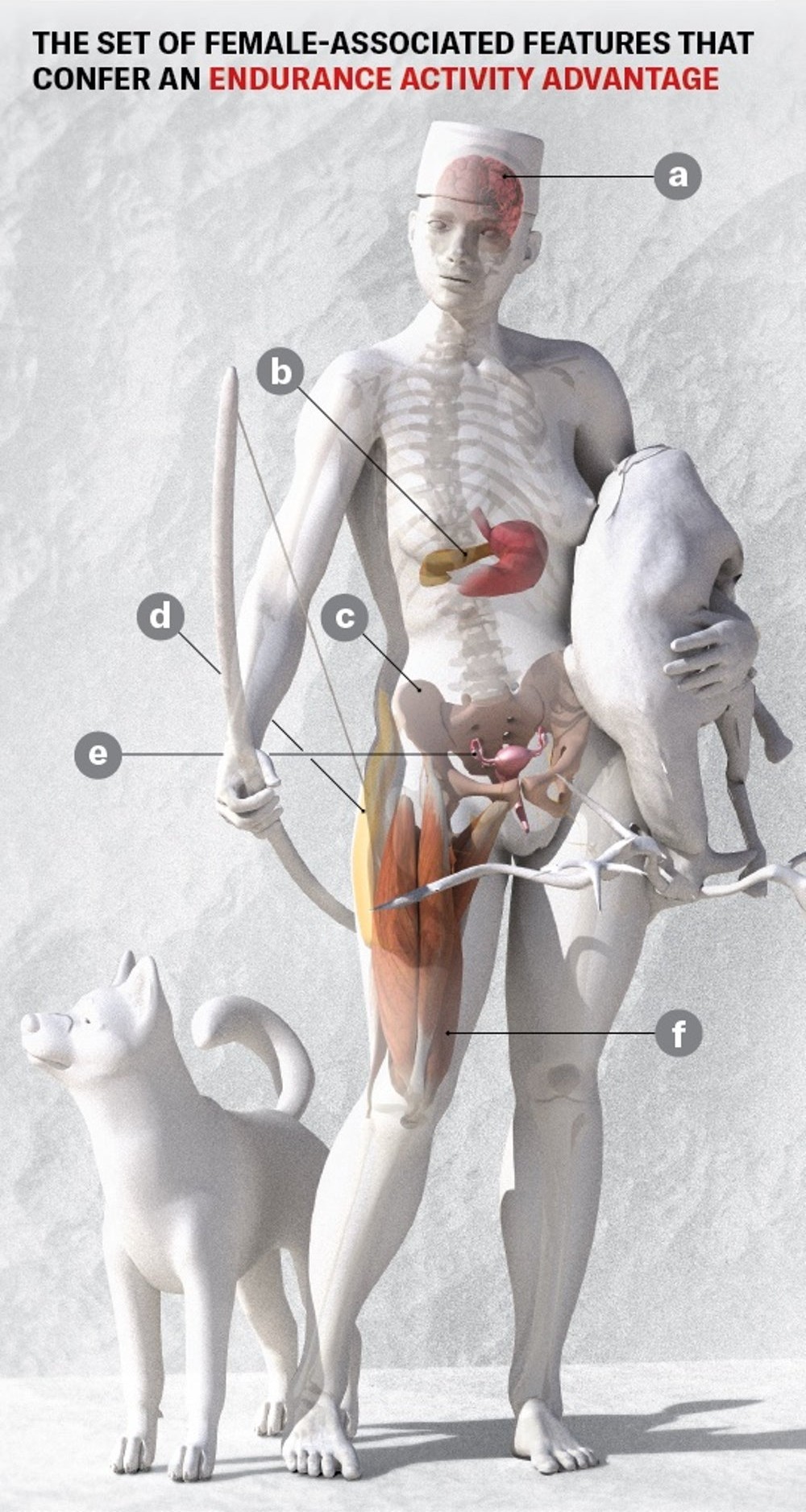
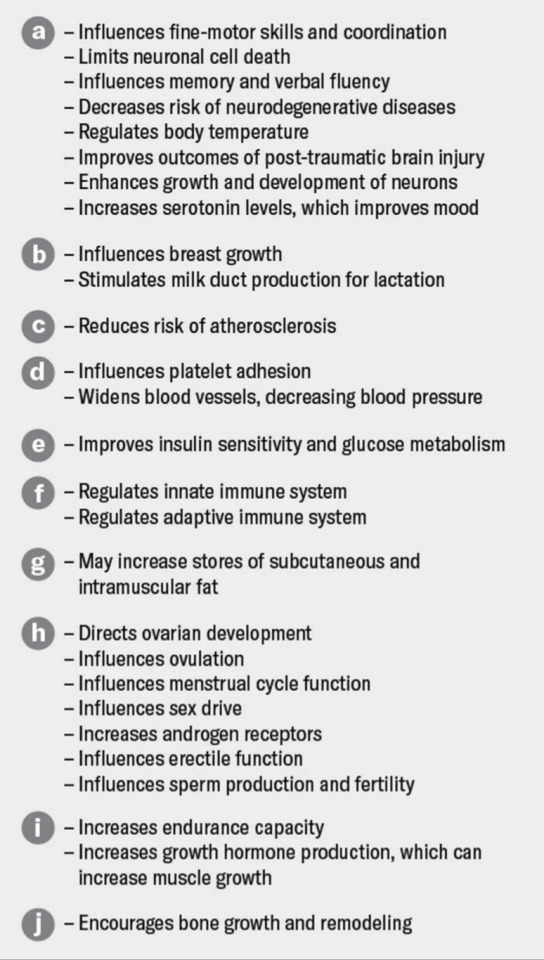
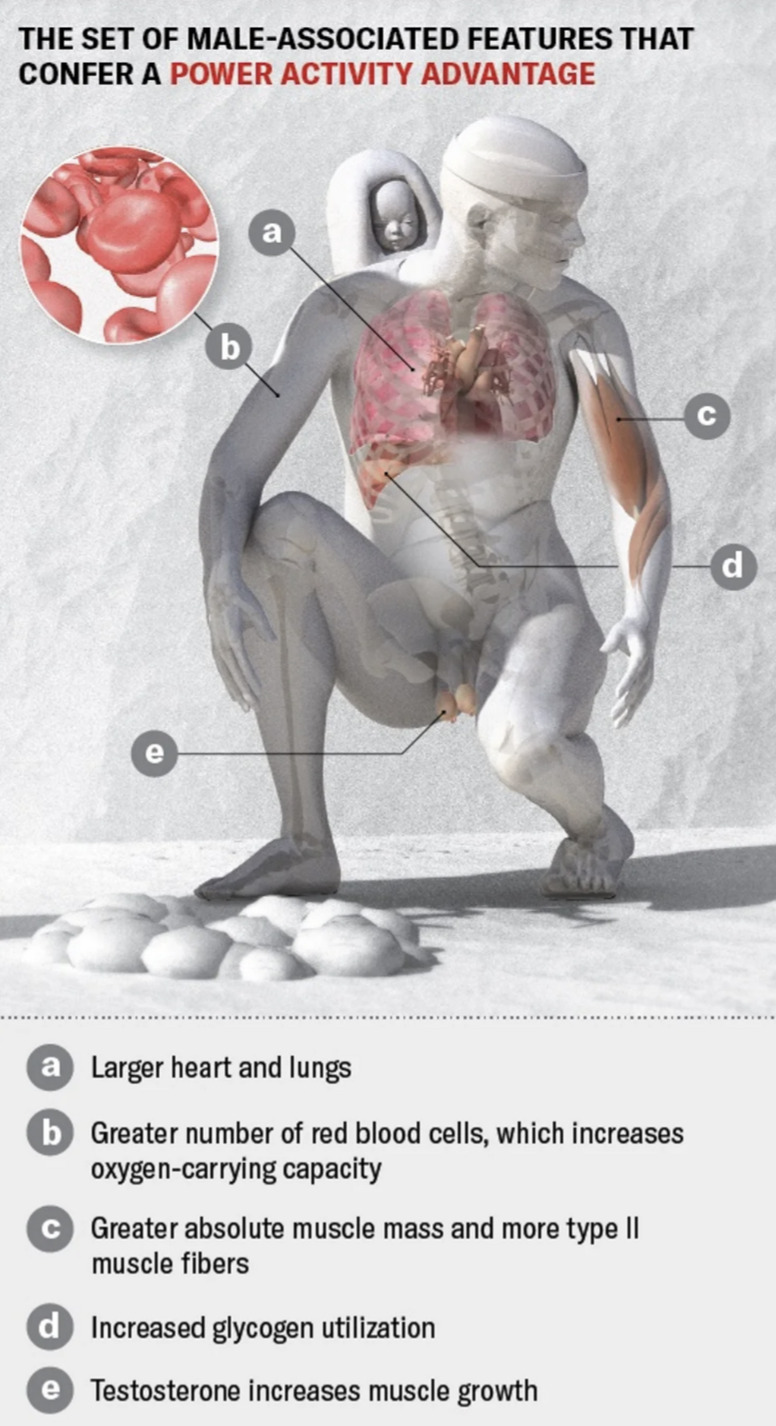
Credit: Violet Isabelle Frances for Bryan Christie Design
Given the fitness world's persistent touting of the hormone testosterone for athletic success, you'd be forgiven for not knowing that estrogen, which females typically produce more of than males, plays an incredibly important role in athletic performance. It makes sense from an evolutionary standpoint, however. The estrogen receptor—the protein that estrogen binds to in order to do its work—is deeply ancient. Joseph Thornton of the University of Chicago and his colleagues have estimated that it is around 1.2 billion to 600 million years old—roughly twice as old as the testosterone receptor. In addition to helping regulate the reproductive system, estrogen influences fine-motor control and memory, enhances the growth and development of neurons, and helps to prevent hardening of the arteries.
Important for the purposes of this discussion, estrogen also improves fat metabolism. During exercise, estrogen seems to encourage the body to use stored fat for energy before stored carbohydrates. Fat contains more calories per gram than carbohydrates do, so it burns more slowly, which can delay fatigue during endurance activity. Not only does estrogen encourage fat burning, but it also promotes greater fat storage within muscles—marbling if you will—which makes that fat's energy more readily available. Adiponectin, another hormone that is typically present in higher amounts in females than in males, further enhances fat metabolism while sparing carbohydrates for future use, and it protects muscle from breakdown. Anne Friedlander of Stanford University and her colleagues found that females use as much as 70 percent more fat for energy during exercise than males.
Correspondingly, the muscle fibers of females differ from those of males. Females have more type I, or "slow-twitch," muscle fibers than males do. These fibers generate energy slowly by using fat. They are not all that powerful, but they take a long time to become fatigued. They are the endurance muscle fibers. Males, in contrast, typically have more type II ("fast-twitch") fibers, which use carbohydrates to provide quick energy and a great deal of power but tire rapidly.
Females also tend to have a greater number of estrogen receptors on their skeletal muscles compared with males. This arrangement makes these muscles more sensitive to estrogen, including to its protective effect after physical activity. Estrogen's ability to increase fat metabolism and regulate the body's response to the hormone insulin can help prevent muscle breakdown during intense exercise. Furthermore, estrogen appears to have a stabilizing effect on cell membranes that might otherwise rupture from acute stress brought on by heat and exercise. Ruptured cells release enzymes called creatine kinases, which can damage tissues.
Studies of females and males during and after exercise bolster these claims. Linda Lamont of the University of Rhode Island and her colleagues, as well as Michael Riddell of York University in Canada and his colleagues, found that females experienced less muscle breakdown than males after the same bouts of exercise. Tellingly, in a separate study, Mazen J. Hamadeh of York University and his colleagues found that males supplemented with estrogen suffered less muscle breakdown during cycling than those who didn't receive estrogen supplements. In a similar vein, research led by Ron Maughan of the University of St. Andrews in Scotland found that females were able to perform significantly more weight-lifting repetitions than males at the same percentages of their maximal strength.
If females are better able to use fat for sustained energy and keep their muscles in better condition during exercise, then they should be able to run greater distances with less fatigue relative to males. In fact, an analysis of marathons carried out by Robert Deaner of Grand Valley State University demonstrated that females tend to slow down less as a race progresses compared with males.
If you follow long-distance races, you might be thinking, wait—males are outperforming females in endurance events! But this is only sometimes the case. Females are more regularly dominating ultraendurance events such as the more than 260-mile Montane Spine foot race through England and Scotland, the 21-mile swim across the English Channel and the 4,300-mile Trans Am cycling race across the U.S. Sometimes female athletes compete in these races while attending to the needs of their children. In 2018 English runner Sophie Power ran the 105-mile Ultra-Trail du Mont-Blanc race in the Alps while still breastfeeding her three-month-old at rest stations.
Inequity between male and female athletes is a result not of inherent biological differences between the sexes but of biases in how they are treated in sports. As an example, some endurance-running events allow the use of professional runners called pacesetters to help competitors perform their best. Men are not permitted to act as pacesetters in many women's events because of the belief that they will make the women "artificially faster," as though women were not actually doing the running themselves.
The modern physiological evidence, along with historical examples, exposes deep flaws in the idea that physical inferiority prevented females from partaking in hunting during our evolutionary past. The evidence from prehistory further undermines this notion.
Consider the skeletal remains of ancient people. Differences in body size between females and males of a species, a phenomenon called sexual size dimorphism, correlate with social structure. In species with pronounced size dimorphism, larger males compete with one another for access to females, and among the great apes larger males socially dominate females. Low sexual size dimorphism is characteristic of egalitarian and monogamous species. Modern humans have low sexual size dimorphism compared with the other great apes. The same goes for human ancestors spanning the past two million years, suggesting that the social structure of humans changed from that of our chimpanzeelike ancestors.

Sophie Power ran the 105-mile Ultra-Trail du Mont-Blanc race in the Alps while breastfeeding her child at rest stations. Credit: Alexis Berg
Anthropologists also look at damage on our ancestors' skeletons for clues to their behavior. Neandertals are the best-studied extinct members of the human family because we have a rich fossil record of their remains. Neandertal females and males do not differ in their trauma patterns, nor do they exhibit sex differences in pathology from repetitive actions. Their skeletons show the same patterns of wear and tear. This finding suggests that they were doing the same things, from ambush-hunting large game animals to processing hides for leather. Yes, Neandertal women were spearing woolly rhinoceroses, and Neandertal men were making clothing.
Males living in the Upper Paleolithic—the cultural period between roughly 45,000 and 10,000 years ago, when early modern humans entered Europe—do show higher rates of a set of injuries to the right elbow region known as thrower's elbow, which could mean they were more likely than females to throw spears. But it does not mean women were not hunting, because this period is also when people invented the bow and arrow, hunting nets and fishing hooks. These more sophisticated tools enabled humans to catch a wider variety of animals; they were also easier on hunters' bodies. Women may have favored hunting tactics that took advantage of these new technologies.
What is more, females and males were buried in the same way in the Upper Paleolithic. Their bodies were interred with the same kinds of artifacts, or grave goods, suggesting that the groups they lived in did not have social hierarchies based on sex.
Ancient DNA provides additional clues about social structure and potential gender roles in ancestral human communities. Patterns of variation in the Y chromosome, which is paternally inherited, and in mitochondrial DNA, which is maternally inherited, can reveal differences in how males and females dispersed after reaching maturity. Thanks to analyses of DNA extracted from fossils, we now know of three Neandertal groups that engaged in patrilocality—wherein males were more likely to stay in the group they were born into and females moved to other groups—although we do not know how widespread this practice was.
Patrilocality is believed to have been an attempt to avoid incest by trading potential mates with other groups. Nevertheless, many Neandertals show both genetic and anatomical evidence of repeated inbreeding in their ancestry. They lived in small, nomadic groups with low population densities and endured frequent local extinctions, which produced much lower levels of genetic diversity than we see in living humans. This is probably why we don't see any evidence in their skeletons of sex-based differences in behavior.
For those practicing a foraging subsistence strategy in small family groups, flexibility and adaptability are much more important than rigid roles, gendered or otherwise. Individuals get injured or die, and the availability of animal and plant foods changes with the seasons. All group members need to be able to step into any role depending on the situation, whether that role is hunter or breeding partner.
Observations of recent and contemporary foraging societies provide direct evidence of women participating in hunting. The most cited examples come from the Agta people of the Philippines. Agta women hunt while menstruating, pregnant and breastfeeding, and they have the same hunting success as Agta men.
They are hardly alone. A recent study of ethnographic data spanning the past 100 years—much of which was ignored by Man the Hunter contributors—found that women from a wide range of cultures hunt animals for food. Abigail Anderson and Cara Wall-Scheffler, both then at Seattle Pacific University, and their colleagues reported that 79 percent of the 63 foraging societies with clear descriptions of their hunting strategies feature women hunters. The women participate in hunting regardless of their childbearing status. These findings directly challenge the Man the Hunter assumption that women's bodies and childcare responsibilities limit their efforts to gathering foods that cannot run away.
So much about female exercise physiology and the lives of prehistoric women remains to be discovered. But the idea that in the past men were hunters and women were not is absolutely unsupported by the limited evidence we have. Female physiology is optimized for exactly the kinds of endurance activities involved in procuring game animals for food. And ancient women and men appear to have engaged in the same foraging activities rather than upholding a sex-based division of labor. It was the arrival some 10,000 years ago of agriculture, with its intensive investment in land, population growth and resultant clumped resources, that led to rigid gendered roles and economic inequality.
Now when you think of "cave people," we hope, you will imagine a mixed-sex group of hunters encircling an errant reindeer or knapping stone tools together rather than a heavy-browed man with a club over one shoulder and a trailing bride. Hunting may have been remade as a masculine activity in recent times, but for most of human history, it belonged to everyone.
27 notes
·
View notes
Text









The History of Four-Footed Beasts and Serpents (1658)
“Never was there so complete a History of the Creatures as this since the daies of Solomon, who writ the Story of Beasts and Creeping things”, claims John Rowland in his dedicatory epistle to Edward Topsell’s 1658 History, which brings together his earlier work on four-footed beasts (1607) and serpents (1608). Published more than thirty years after its author’s death and considered the first major illustrated work on animals printed in English, this epic treatise on zoology exceeds a thousand pages, exploring ancient and fantastic tales of real animals, as well as those at the more legendary end of the spectrum, including the “Hydra” (with two claws, a curled serpent’s tail, and seven small mammalian heads), the “Lamia” (with a cat-like body and woman’s face and hair), and the “Mantichora” (with a lion’s body and mane, man’s face and hair, and a grotesque grin, filled with multiple rows of teeth).
Topsell was not a naturalist himself (he in fact was a clergyman) and so heavily quotes the observations of others, in particular Thomas Moffett and Konrad Gesner — the Swiss scholar from whom Topsell reproduced the book’s brilliant woodcut illustrations — who, in turn, relied on classical authorities like Aristotle, Ovid, and Pliny. On utilizing the works of others, Topsell writes: “I would not have the Reader . . . imagine I have . . . related all that is ever said of these Beasts, but only so much as is said by many”. This approach leads him to repeat some wonderful cock-and-bull stories: elephants are said to worship the sun and the moon with their own rituals, apes are terrified of snails, and “the horn of the unicorn . . . doth wonderfully help against poyson”. Although it abounds with such fanciful ideas, Topsell’s work, as John Lienhard explains, “was actually an early glimmer of modern science. For all its imperfection, it represents a vast collection of would-be observational data, and it even includes a rudimentary rule for sifting truth from supposition.”
The illustrations seem to infuse these animals with the properties that are attributed to them: the hedgehog looks positively petrified, perhaps due to its habit of drinking wine; the shrew seems to snicker, for it “beareth a cruel minde, desiring to hurt anything” (you may kill them with shovels, notes the text, or bury them as Egyptians do); and the mimick, or Getulian dog, which is said to have once called England home, appears to plot its next feat of deception. This final creature was so good at aping the behavior of humans that “in many poor mens houses they served instead of servants for diverse uses”, and were known for their capacity to put on plays, acting out several roles at once. The book’s index is almost as evocative as its illustrations — highlighting the myriad medicinal properties attributed to animals in this period — and shocks the contemporary reader at almost every turn. Choosing a letter at random, “v” points to pages on “venomous beasts driven away”, “vertigo”, “virgins breasts great”, “voice weak”, and “vomit”.
Topsell compiled his book to “delight the reader, whereinto he may look on the holiest deities”. And indeed, a sense of natural wonder — maintained for millennia — courses through this treatise. Yet much of the enchantment here is infused with “Topsell’s belief that his animals have human intrinsic worth and moral qualities as well as a hatred of mankind”, writes Helen Westhrop. Even when they lack the human expressions of Lamias and Mantichoras, the animals that come before the clergyman’s eye cannot escape their fate to serve as screens on which to project our species’ virtues as well as vices.
https://publicdomainreview.org/.../the-history-of.../...
18 notes
·
View notes
Text
You like reading fanfics? How about reading about fanfics? 😏
Here’s what I've read so far (or am currently getting through) for my dissertation on fanfiction bookbinding! I'll be updating it as I go until the end of July. If you have any recs to add to the towering pile or any questions/opinions about something on there, I’m all ears!
on fan studies & ficbinding ✔
Alexander, Julia, ‘Making fanfiction beautiful enough for a bookshelf’, The Verge, 9 March 2021 <https://www.theverge.com/22311788/fanfiction-bookbinding-tiktok-diy-star-wars-harry-potter-twitter-fandom> [accessed 12 June 2024]
Buchsbaum, Shira Belén, ‘Binding fan fiction and reexamining book production models’, Transformative Works and Cultures, 37 (2022)
Dym, Brianna, and Casey Fiesler, ‘Ethical and privacy considerations for research using online fandom data’, Transformative Works and Cultures, 33 (2020)
Jenkins, Henry, Textual Pochers: Television Fans and Participatory Culture (New York: Routeledge, 1992)
Jenkins, Henry, ‘Transmedia Storytelling 101’, Pop Junctions, 21 March 2007 <http://henryjenkins.org/2007/03/transmedia_storytelling_101.html#sthash.gSETwxQX.dpuf> [accessed 12 June 2024]
Hellekson, Karen, ‘Making Use Of: The Gift, Commerce, and Fans’, Cinema Journal, 54, no. 3 (2015), 125–131
Kennedy, Kimberly, ‘Fan binding as a method of fan work preservation’, Transformative Works and Cultures, 37 (2022)
Minkel, Elizabeth, ‘Before “Fans,” There Were “Kranks,” “Longhairs,” and “Lions”: How Do Fandom Gain Their Names?’, Atlas Obscura, 30 May 2024 <https://www.atlasobscura.com/articles/fandom-names> [accessed 12 June 2024]
Penley, Constance, Nasa / Trek: Popular Science and Sex in America (London: Verso, 1997)
Price, Ludi, ‘Fanfiction, Self-Publishing, and the Materiality of the Book: A Fan Writer’s Autoethnography’, Humanities, 11, no. 100 (2022), 1–20
Schiller, Melanie, ‘Transmedia Storytelling: New Practices and Audiences’, in Stories: Screen Narrative in the Digital Era, ed. by Ian Christie and Annie van den Oever (Amsterdam: Amsterdam University Press, 2018), 99–107
on folklore, the internet, other background reading ✔
Barthes, Roland, ‘La mort de l’auteur’ in Le Bruissement de la langue: Essais critiques IV (Paris: Éditions du Seuil, 1984)
Blank, Trevor J., Folklore and the Internet: Vernacular Expression in a Digital World (Logan, Utah: Utah State University Press, 2009)
Mauss, Marcel, ‘Essai sur le don. Forme et raison de l’échange dans les sociétés archaïques.’, L’année sociologique, 1923–1924; digital edition by Jean-Marie Tremblay, Les classiques des sciences sociales, 17 February 2002, <http://classiques.uqac.ca/classiques/mauss_marcel/socio_et_anthropo/2_essai_sur_le_don/essai_sur_le_don.html> [accessed 10 June 2024]
McCulloch, Gretchen, Because Internet: Understanding How Language is Changing (Random House, 2019)
Niles, John D., Homo Narrans: The Poetics and Anthropology of Oral Literature (University of Pennsylvania Press: Philadelphia, 1999)
hopefully coming up next (haven't started yet)
A Companion to Media Fandom and Fan Studies, ed. by Paul Booth (Hoboken: John Wiley & Sons, Inc., 2018)
A Fan Studies Primer: Method, Research, Ethics, ed. by Paul Booth and Rebecca Williams (Iowa City: University of Iowa Press, 2021)
Dietz, Laura, ‘Showing the scars: A short case study of de-enhancement of hypertext works for circulation via fan binding or Kindle Direct Publishing’, 34th ACM Conference on Hypertext and Social Media (HT ‘23), September 4–8, 2023, Rome Italy (ACM: New York, 2023)
Fathallah, Judith May, Fanfiction and the Author: How Fanfic Changes Popular Cultural Texts (Amsterdam: Amsterdam University Press, 2017)
Finn, Kavita Mudan, and Jessica McCall, ‘Exit, pursued by a fan: Shakespeare, Fandom, and the Lure of the Alternate Universe’, Critical Survey, 28, no. 2 (2016), 27–38
Hjorth, Larissa et al., eds. The Routledge Companion to Digital Ethnography (New York: Routledge Taylor & Francis Group, 2017)
Jacobs, Naomi, and JSA Lowe, ‘The Design of Printed Fanfiction: A Case Study of Down to Agincourt Fanbinding’, Proceedings from the Document Academy, 9, issue 1, article 5
Jenkins, Henry, Convergence Culture: Where Old and New Media Collide (New York: New York University Press, 2006)
Jenkins, Henry, Spreadable Media: Creating Value and Meaning In A Networked Culture (New York: New York University Press, 2013)
Kennedy, Kimberly, and Shira Buchsbaum, ‘Reframing Monetization: Compensatory Practices and Generating a Hybrid Economy in Fanbinding Commissions’, Humanities, 11, no. 67 (2022), 1–18
Kirby, Abby, ‘Examining Collaborative Fanfiction: New Practices in Hyperdiegesis and Poaching’, Humanities, 11, no. 87 (2002), 1–9
Kustritz, Anne, Identity, Community, and Sexuality in Slash Fan Fiction (New Work: Routeledge, 2024)
Lamerichs, Nicolle, Productive Fandom: Intermediality and Affecive Reception in Fan Cultures, (Amsterdam: Amsterdam Universtiy Press, 2018)
Popova, Milena, ‘Follow the trope: A digital (auto)ethnography for fan studies’, Transformative Works and Cultures, 33 (2020)
Rosenblatt, Betsy, and Rebecca Tushnet, ‘Transformative Works: Young Women’s Voices on Fandom and Fair Use’, in eGirls, eCitizens: Putting Technology, Theory and Policy into Dialogue with Girls’ and Young Women’s Voices, ed. by Jane Bailey and Valerie Steeves
Soller, Bettina, ‘Filing off the Serial Numbers: Fanfiction and its Adaptation to the Book Market’, in Adaptation in the Age of Media Convergence, ed. by Johannes Fehrle, Werner Schäfke-Zell (Amsterdam: Amsterdam University Press, 2019), 58–85
#fanbinding dissertation#fanbinding lit#bibliography#dissertation#reading list#gradblr#study blog#research#fanfiction#bookbinding#fanbinding#ficbinding#fanfic#ethnology#folklore#currently reading
45 notes
·
View notes
Text
By: Benjamin Ryan
Published: Oct 24, 2024

[ That’s a quote from a talk that pediatric gender medicine doctor Johanna Olson-Kennedy gave in which she was dismissing concerns about young people potentially regretting getting double mastectomies for a gender transition. ]
Some of the biggest names in the pediatric gender medicine field are part of an entrenched global trend in which they prioritize the transgender advocacy mission over honest and direct science. They hide inconvenient research findings. And they seek to prevent other researchers from even asking questions that might yield inconvenient answers. Supporting them is a cabal of activists and LGBTQ nonprofits standing at the ready to bully and cancel any scientists or journalists who might bring to light any of the more questionable aspects of pediatric gender medicine.
This pattern is not just limited to Children’s Hospital Los Angeles’ Dr. Johanna Olson-Kennedy. If you haven’t already heard, according to reporting in The New York Times, this major leader in the pediatric gender medicine field has been sitting on null findings from her National Institutes of Health–funded study of puberty blockers for gender dysphoric children because, she said, publishing them would prove politically inexpedient. (I wrote about an undercover video of her talking about mastectomies here.)
Where have we heard this story before?
Let’s take a trip across the pond to the British National Health Service’s now-shuttered pediatric gender clinic, GIDS. (I encourage you to read all about this troubled clinic in Hannah Barnes’ book Time to Think. Make sure to get the new 2024 U.S. paperback, which has a vital new epilogue.) After it was founded in 2011, GIDS’s leaders sought to recreate the findings of the original Dutch protocol that was first cultivated in the mid-1990s and that ultimately gave rise to the global pediatric gender-transition treatment movement during the 2000s and 2010s.
But the British team failed. They did not find a substantial benefit from providing puberty blockers to gender dysphoric children by following the Dutch protocol. So did these researchers alert the world to their troublesome findings? Did they send a word of caution to a field that by then was circumnavigating the globe, setting up what would soon be hundreds of pediatric gender-clinic outposts?
No, they kept their failure secret.
It wasn’t until Oxford sociologist Michael Biggs became suspicious and ultimately rooted out the truth that the GIDS clinicians finally owned up and published their failed study.

Also in England, the NHS’s Cass Review, which was published in April after a four-year effort to assess pediatric gender medicine at home and worldwide, sought to assess the long-term outcomes of the wider population of former GIDS patients. But the adult NHS gender clinics refused to share their de-identified data on those now-adult patients, providing only specious reasons for their refusal.
Now it seems as if the NHS will ultimately force them to do so. But for now, the world is poorer for not having that data. Because this entire field is compromised by a woeful lack of long-term data, in particular about the more recent cohorts of gender-dysphoric adolescents who have undergone gender-transition treatment, and whose profiles are vastly different from those kids who entered the original Dutch study.
After the Cass Review came out, activists went into overdrive to tell wild falsehoods about it, as I reported at the time. Hilary Cass, the pediatrician lead author of the report, was appalled, and told a reporter that those activists were harming children.
There are also plenty of examples of academics being discouraged from even asking research questions that might lead to an answer that would prove inconvenient for the pediatric gender medicine movement. Take, for example, the trio starting a long-term study to assess whether rapid-onset gender dysphoria is a true phenomenon. These three seasoned investigators have had to self-fund their research and are subject to persistent derision and scorn by trans activists for daring to ask difficult questions about this medical field and about the reasons for the recent surge in trans identification in natal girl adolescents in particular.
One of those three investigators, physician-researcher Dr. Lisa Littman, spoke to me for my article on The Trans Tipping Point in the New York Post. She said of the activists who attack her: “It’s as if their loyalty is to the transition interventions and not to the long-term health and well-being of transgender-identified young people.”

Here’s another example. When UCL neuropsychologist Sallie Baxendale sought to obtain peer review for her review paper about what scientists know—and don’t know—about the neuropsychiatric impacts of puberty blockers, here was what happened, according to what she wrote in Unherd:
None of the reviewers identified any studies that I had missed that demonstrated safe and reversible impacts of puberty blockers on cognitive development, or presented any evidence contrary to my conclusions that the work just hasn’t been done. However, one suggested the evidence may be out there, it just hadn’t been published. They suggested that I trawl through non-peer reviewed conference presentations to look for unpublished studies that might tell a more positive story. The reviewer appeared to be under the naïve apprehension that studies proving that puberty blockers were safe and effective would have difficulty being published. The very low quality of studies in this field, and the positive spin on any results reported by gender clinicians suggest that this is unlikely to be the case. Another reviewer expressed concerns that publishing the conclusions from these studies risked stigmatising an already stigmatised group. A third suggested that I should focus on the positive things that puberty blockers could do, while a fourth suggested there was no point in publishing a review when there wasn’t enough literature to review. Another sought to diminish an entire field of neuroscience that has established puberty as a critical period of brain development as “my view”.
Dr. Baxendale ultimately published her vital review paper, which concluded: “Critical questions remain unanswered regarding the nature, extent and permanence of any arrested development of cognitive function associated with puberty blockers. The impact of puberal suppression on measures of neuropsychological function is an urgent research priority.”
Meanwhile, the American Academy of Pediatrics has assured the public in its 2018 policy statement on the gender-affirming care method that puberty blockers are “reversible.” Twenty Republican attorneys general recently sent a stern, probing letter to the AAP, suggesting that that claim, which they assert is false, violates consumer protection laws. A lawsuit is likely imminent. The AAP is already being sued by a detransitioner over the statement. The original legal complaint lambasts the AAP for never responding to Canadian sex researcher James Cantor’s scathing fact check and critique he published of the policy statement in 2019.
Personally, I don’t think the claim that puberty blockers are reversible is definitively false, given what science is able to tell us at this time. But on the flip side, we also know that it is not definitely true either. As Dr. Baxendale’s paper demonstrates, there remain too many substantive and unanswered questions about how using drugs that throw vital human development processes out of synch might impact a young person, possibly for the rest of their lives.
The AAP announced in August 2023 that it was going to conduct a systematic literature review of the evidence behind pediatric gender medicine—and then never said another word about it. The authors of such reviews are expected to publish their methodology in advance, and the there is no sign that the AAP has done so.
Then there’s the World Professional Association for Transgender Health, or WPATH, which as the Alabama attorney general’s subpoenas have revealed and Jesse Singal reported for The Economist in June, suppressed systematic literature reviews about this field that it commissioned from Johns Hopkins. And after a Biden Health official and the AAP strong armed WPATH into removing the age restrictions on gender-transition treatment and surgeries in the update to its trans-care guidelines in 2022, WPATH president Dr. Marci Bowers coordinated for the leadership to lie about why they had done so. All of this is detailed in scathing, unsparing detail in the Alabama AG’s amicus brief to the Supreme Court, which argues that the court should uphold Tennessee’s law banning pediatric gender-transition treatment.
And in the wake of today’s news about Dr. Olson-Kennedy, we have an example of yet another front in this battle over pediatric medicine: the sheer denial and deflection coming from transgender activist Ari Drennen of Media Matters and the LGBTQ “media watchdog” GLAAD. As you can see from the tweet below, all they could do in the face of such a damning report was deflect.

This makes me wonder: What exactly is GLAAD’s endgame? This is the same nonprofit that had the temerity to condescend to the New York Times last year and falsely claim that the “science is settled” on pediatric medicine with their protest truck they drove around the Times building in Midtown Manhattan.

The science is, of course, not settled. No science is. It is always evolving, in particular in this tempestuous and troubled field of pediatric gender medicine. And there are many people in this wider movement who are seeking to suppress the full, ever-changing truth from coming to light.
At the center of this story is a burgeoning population of very troubled children. They are owed the best science possible. They are owed the truth, whatever that might be.
==
I previously posted about Olsen-Kennedy's tone-deaf endorsement of medical mutilation.
Imagine a medical study of a cancer treatment that was found to be ineffective, which was then covered up. Why would a report about that coverup need to quote people who had had cancer? These fanatics think we're stupid.
People wonder why the trust in our institutions is so low. It's because they keep producing this kind of fraud, which isn't science any more than Intelligent Design is science.
When the devoutly Christian John Templeton Foundation funded a study on intercessory prayer, they were forced to publish it, even though it found that it was ineffective. Or worse.
Conclusions Intercessory prayer itself had no effect on complication-free recovery from CABG, but certainty of receiving intercessory prayer was associated with a higher incidence of complications.
These genderists are doing religious proselytization.
#Benjamin Ryan#Johanna Olsen Kennedy#medical scandal#medical corruption#medical malpractice#fraud#medical fraud#scientific fraud#this is not science#science#gender affirming care#gender affirming healthcare#gender affirmation#academic corruption#religion is a mental illness
12 notes
·
View notes
Text
Language and computers (Open Access)
Lelia Glass, Markus Dickinson, Chris Brew, Detmar Meurers
This book offers an accessible introduction to the ways that language is processed and produced by computers, a field that has recently exploded in interest. The book covers writing systems, tools to help people write, computer-assisted language learning, the multidisciplinary study of text as data, text classification, information retrieval, machine translation, and dialog. Throughout, we emphasize insights from linguistics along with the ethical and social consequences of emerging technology. This book welcomes students from diverse intellectual backgrounds to learn new technical tools and to appreciate rich language data, thus widening the bridge between linguistics and computer science.
#linguistics#lingblr#academia#langblr#phd life#computer science#natural language#Language and Computers
9 notes
·
View notes
Text
This day in history

I'll be in TUCSON, AZ from November 8-10: I'm the GUEST OF HONOR at the TUSCON SCIENCE FICTION CONVENTION.

#20yrsago Bhutan: World’s biggest book https://kottke.org/04/10/bhutan-book
#15yrsago Anti-vaccine fear versus science https://web.archive.org/web/20091022235649/https://www.wired.com/magazine/2009/10/ff_waronscience/all/1
#10yrsago Sen Lindsay Graham promises a fine future for “white men in male-only clubs” https://www.politico.com/story/2014/10/sen-lindsey-graham-white-men-joke-112338
#10yrsago Hungary cancels proposed Internet tax in the face of mass opposition https://www.bbc.com/news/world-europe-29846285
#10yrsago David Graeber and Thomas Piketty on whether capitalism will destroy itself https://thebaffler.com/odds-and-ends/soak-the-rich
#10yrsago USPS usage declines, but sloppy postal surveillance is way, way up https://www.politico.com/story/2014/06/snail-mail-snooping-safeguards-not-followed-108056
#5yrsago How the British left should seize this moment to strip finance of its political clout https://www.opendemocracy.net/en/oureconomy/thatcher-had-a-battle-plan-for-her-economic-revolution-now-the-left-needs-one-too/
#5yrsago After suing NSO Group for hacking Whatsapp, Facebook kicks NSO employees off its services https://arstechnica.com/information-technology/2019/10/facebook-permanently-deletes-the-accounts-of-nso-workers/
#5yrsago The right is bankrolled by self-interested one-percenters making long-term investments; the left, by one-percenters with “moral whims” https://nymag.com/intelligencer/2019/10/how-did-democrats-lose-the-states-money-money-money.html
#5yrsago Leaked document reveals that Sidewalk Labs’ Toronto plans for private taxation, private roads, charter schools, corporate cops and judges, and punishment for people who choose privacy https://www.theglobeandmail.com/business/article-sidewalk-labs-document-reveals-companys-early-plans-for-data/
#1yrago The impoverished imagination of neoliberal climate "solutions" https://pluralistic.net/2023/10/31/carbon-upsets/#big-tradeoff

Tor Books as just published two new, free LITTLE BROTHER stories: VIGILANT, about creepy surveillance in distance education; and SPILL, about oil pipelines and indigenous landback.

10 notes
·
View notes